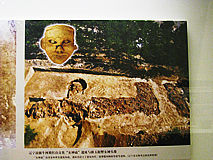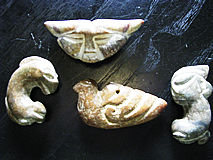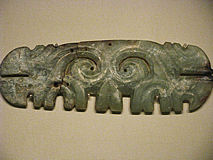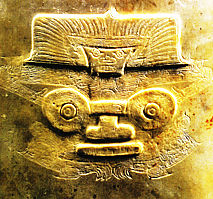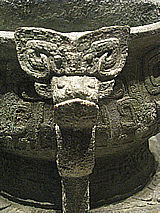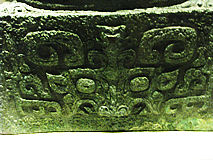CultureRenewalInitiative
HEALING THE PLANET
To begin with yourself
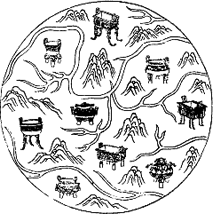
THE NINE DING
Emperor Yü the Great conquered nine provinces and linked each to a Ding or
Vessel of Abundance. To link the land ("Lady of the Land") with the Womb symbol
is very archaic and can also be found in the West e.g. the Grail Legend. Ever since the
"Nine Ding" is connected to Sovereignty (of the Son of Heaven, the Emperor)

Popular arrangement of the "Nine Ding"
Mother China 1
(Chinese Mother Religion)
| There are many different Creation Myths in China. The most prominent one is the story about the Black Cosmic Egg. "In the beginning" there was only a Dark Void. In this Egg the "Son" (foetus) Pan Gu waited for his birth. Once born he found himself in between Heaven and Earth. With all might he managed to separate them. Once the latter was stabilized Pan Gu died. | CREATION MYTH
Proof of the fact that this insight is still very much alive shows this statue of "Maitreya in the Egg" |
It isn't difficult to realize that this Creation Myth goes to the core of things. The Black Cosmic Egg is the Dark Cosmic Womb giving birth to the Eternal Light (embodied by "Pan Gu", Her "Son" and first emanation). The latter in its turn "created "Heaven and Earth" (the second emanation). This reminds one very much of the legend of the Greek God Hercules. The latter by the way also "a Son of the Mother". After the world has materialized and thus being a stable foundation for life "Pan Gu" leaves it on its own and retires. The Divine becoming invisible ("dies") to common people. |
| THE WESTERN PARADISE | This Creation Myth is very much similar to ultimate spiritual insight. It is supported by science too. The Origin of both "God" and the universe is the Cosmic Womb. Hence early Chinese culture had a "feminine" world view. It corresponds with insights of Tibetan Bön and the Veda's (Upanishads), where the Origin is also defined as a Cosmic Egg. Ultimately, it could all go back to Mesopotamia |
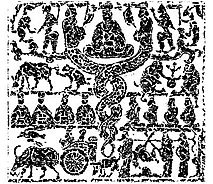 Xiwangmu with Nüwa (Yin) and Fuxi (Yang) |
| Kunlun, the Western Paradise is a dream land for Taoists, Bön people and Tibetans alike. It is the homeland of Xiwangmu, the Queen Mother of the West. She must be very old, for "Paradise" is only used for a time before written culture. That's why the Bönpo say, that their tradition is universal and without name. Xiwangmu almost certainly comes from the West herself: from Anatolia. | QUEEN MOTHER OF THE WEST |
It should not be forgotten that for tens of thousands of years prehistoric cultures, ranging from Western Europe to the Pacific, covering the whole of Central Asia had been dominated by MotherGoddess worship. Countless terracotta statues and figurines makes this a proven fact. To assume a MotherGoddess somewhere or links between them in later times e.g. in the Bronze period has to be seen in that context. |
 Xiwangmu and Her birds |
Thus e.g. no need to prove that Xiwangmu is "related" to other MotherGoddesses. Of course, She is. She has been embedded in a Mother-centered culture for millennia. Which particular connections there have been is open to discussion. Most likely She is linked to the Great Mother of Catal Hüyok and as a consequence to the Great Mother Kybele (See later) |
 Black faced Xiwangmu |
| Matriarchal culture was destroyed after the Shang Dynasty. It means that very little has survived the centuries. That's why legends and myths necessarily play an important role. Nevertheless, what I could find with regard to archeological evidence I will display here. China has had many historical periods and regional hotspots. These (partly pre-historic) cultures e.g. are "Hongshan", "Liangzhu", "Majiayao", "Western Zhou", and "Xixia" to name only a few |
Goddess mask |
(PRE)HISTORIC CHINA Hongshan (4700-2900 BCE) |
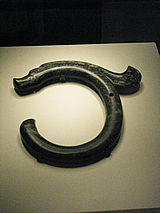 Primordial Dragon |
The Hongshan culture contains both elements of the MotherGoddess as well as Her "Son/Lover", the Dragon |
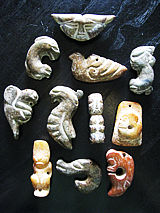 Objects from Hongshan culture |
Left Primordial Dragon |
||
 Second from left a Phoenix, second from right a Goddess |
Sensational are the Dragons who are draped in a circle. It symbolizes early stages of development in which the Dragon is still part of the Cosmic Womb. Later he emancipated, often still connected to the womb symbol (see later) in order to eventually get shapes of his own |
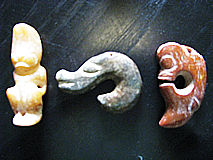 Goddess and two dragons |
Animal mask |
||
Liangzhu |
||
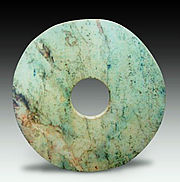 Womb/Tao |
These images known to everyone symbolize the Cosmic Womb. Only later the emphasis on the Tao (Wholeness) was made. Recent interpretations once again define the Tao as Cosmic Womb. By the way Lao Tze already talks about the "Mother of all" and the "Female Spirit of the Valley", which is the same |
 |
|
||
Majiayao |
||
 Primordial Mother displaying Her vulva, symbolizing the Cosmic Womb |
"The art of pottery is a female
invention" "At the centre of the feminine elementary character in which the
woman contains and protects, nourishes and gives birth, stands the vessel, which is both
attribute and symbol of feminine nature". "The clay vessel, and later the vessel in general is....a symbol of the female deity (Hoernes) |
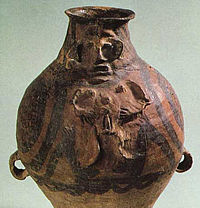 Ditto |
| The Womb as Origin of the Cosmos can be found in many other cultures ("Baubo", Hindu, Canaanite, Buddhist, "Sheela-Na-Gig" and others) |
Ditto |
|
Shang |
||
| IN THE BEGINNING....MEN KNEW THEIR MOTHERS
ONLY.... Pai Hu T'ung (Han Dynasty) |
Ding |
|
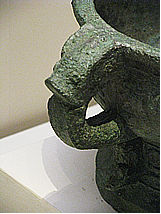 With Beast (Dragon?) ornament |
"The Mother Pot is really a
fundamental conception in all religions, and is almost worldwide in its distribution. The
pot's identity with the Great Mother is deeply rooted in ancient belief through the
greater part of the world" In Southern India a group of seven Goddesses is worshipped in the shape
of seven pots" (Similarly in Northern Borneo and the Philippines) |
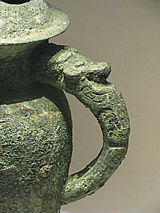 Reminds
me of famous Celtic Vessel in the museum of Salzburg. Indeed, both have their roots in the
same Womb "archetype". |
|
||
 Bird Mother |
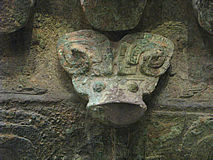 Son Pig |
|
| The "Ding" is an ancient (Shang Dynasty) ceremonial vessel. It served as the Cauldron of Abundance. First of all the emperor wrote his decrees on them, emphasizing that the latter were a gift from "Heaven". Furthermore the Ding symbolized dominion over the land. The correspondence with the Grail legend is striking. Both the Vessel and the land are relating to the Eternal Feminine. We can assume that the early (Shang) emperors were aware of the fact that they ruled "in the name of the Mother" |
|
|
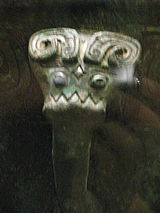 The Son/Beast with Mother Spirals on his head |
Having said this many "secrets" reveal themselves. The Taotie (see below) is the ancient "Face of the Mother", while the animal heads - pigs, dragons, lions, birds - so often depicted on the Dings embody the "Beasts of the Lady", in fact Her Beasts/Sons, comparable to the Western Green Beasts/Men |
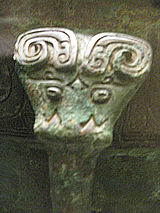 |
Western Zhou |
||
Once again: the Womb-Vessel with Her Son/Beast (Pig) |
Even more characteristic are three-legged Dings. Some, once again are strikingly similar to those of Pre-Columbian (South/Meso-American) art | |
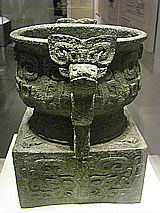 |
The Pig as the Beast of the Mother |
 |
Taotie: the Great Mother (on the base) or Kirtimukha (Kala) of ancient China |
||
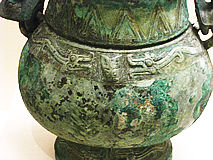 Precursor of the "Lady and Her Beasts (two Dragons). See also later |
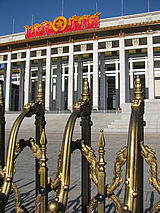 National Museum of China |

In order to have a full overview of the
work,
we recommend you to first going back to the beginning of
Han Marie Stiekema's website.
Please, click HOME and proceed from there.
COSMIC MOTHER
![]() East/West
East/West
Twelve Religions
Green Men & Wise Women
China
Java
1997-2012
© Copyright Han Marie Stiekema. All rights reserved.
Everyone may use this website as a source of inspiration. However, since it
is freely given, no-one can claim, copy or derive any text, rights,
position or status from this website.
Last revising: 07/03/18

